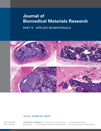
Regenerative Biomaterials
Scope & Guideline
Pioneering Innovations in Tissue Engineering
Introduction
Aims and Scopes
- Biomaterials Design and Synthesis:
Research into the design and synthesis of novel biomaterials, including hydrogels, scaffolds, and nanoparticles, tailored for specific regenerative applications in various tissues. - Tissue Engineering Strategies:
Exploration of innovative tissue engineering strategies that utilize biomaterials to support cell growth, differentiation, and tissue integration. - Biocompatibility and Bioactivity Evaluation:
Studies that assess the biocompatibility, bioactivity, and degradation profiles of biomaterials, ensuring their suitability for clinical applications. - Regenerative Medicine Applications:
Application-focused research that investigates the use of biomaterials in regenerative medicine, including wound healing, bone regeneration, and soft tissue repair. - Nanotechnology in Biomaterials:
Utilization of nanotechnology to enhance the properties and functionalities of biomaterials, improving their efficacy in regenerative medicine. - Multifunctional Biomaterials:
Development of multifunctional biomaterials that can provide therapeutic benefits, such as controlled drug delivery, anti-inflammatory effects, and antimicrobial properties.
Trending and Emerging
- 3D Bioprinting and Fabrication Techniques:
An increasing number of publications are focusing on 3D bioprinting technologies, which allow for the precise fabrication of biomaterials and tissue constructs that mimic natural tissues. - Smart and Responsive Biomaterials:
There is a growing interest in the development of smart biomaterials that can respond to environmental stimuli (e.g., pH, temperature, light) for controlled drug delivery and tissue regeneration. - Regenerative Applications of Nanomaterials:
Research is trending towards the application of nanomaterials in regenerative medicine, particularly in enhancing the properties of biomaterials and in targeted therapies. - Immunomodulatory Biomaterials:
Emerging research is focusing on biomaterials designed to modulate immune responses, which is critical for improving healing outcomes in various regenerative contexts. - Biomaterials for Chronic Wound Healing:
There is an increasing emphasis on developing biomaterials specifically aimed at addressing chronic wounds, with innovative approaches to enhance healing and reduce complications. - Integration of Machine Learning in Biomaterials Research:
The integration of machine learning and computational techniques to predict biomaterial behavior and optimize designs is gaining traction in the journal's publications.
Declining or Waning
- Traditional Biomaterials:
There is a noticeable decline in the publication of studies focused solely on traditional biomaterials without innovative modifications or applications, as the field increasingly emphasizes novel designs and multifunctionality. - Conventional Drug Delivery Systems:
Research centered on conventional drug delivery systems is waning, with a shift towards more complex, multifunctional systems that combine biomaterials with advanced drug delivery mechanisms. - Static Cell Culture Studies:
The prevalence of static in vitro cell culture studies is decreasing as researchers move towards more dynamic, 3D culture environments that better mimic in vivo conditions for tissue engineering. - Single-Function Biomaterials:
There is a reduction in the development and publication of single-function biomaterials, as the trend shifts towards creating multifunctional systems that address multiple therapeutic needs. - Surface Modification Techniques:
Research specifically focused on basic surface modification techniques is declining, with a growing emphasis on advanced techniques that integrate biological cues for improved biomaterial performance.
Similar Journals

Regenerative Engineering and Translational Medicine
Empowering Progress in Translational MedicineRegenerative Engineering and Translational Medicine is an esteemed academic journal published by Springer Heidelberg, focusing on the interdisciplinary fields of biomaterials, biomedical engineering, and cell biology. With an ISSN of 2364-4133 and an E-ISSN of 2364-4141, the journal has carved a niche for itself since its inception in 2015, showcasing cutting-edge research that bridges the gap between scientific findings and practical applications in regenerative medicine. As a recognized platform in its field, it is currently positioned within Q3 quartiles in biomaterials, biomedical engineering, and medicine (miscellaneous), with a Scopus ranking that reflects its growing influence among peers. The journal aims to disseminate high-quality, peer-reviewed articles that highlight advancements in regenerative engineering, further advancing both theoretical and applied research. Scholars and practitioners seeking to stay at the forefront of the ever-evolving landscape of regenerative health solutions will find invaluable insights and innovations within these pages. Join a community of leading thinkers and explore the journal's comprehensive research contributions, which are crucial for fostering partnerships between academia and industry in the quest for transformative medical solutions.

ACS Biomaterials Science & Engineering
Fostering Innovation Through Rigorous Research and CollaborationACS Biomaterials Science & Engineering, published by the American Chemical Society, serves as a premier platform for the latest advancements and research in the fields of biomaterials and biomedical engineering. With an impressive impact factor and a strong reputation reflected in its ranking—Q2 in Biomaterials and Q1 in Biomedical Engineering—the journal attracts a diverse and engaged readership. Since its inception in 2015, it has aimed to foster innovation by publishing high-quality research articles, reviews, and perspectives on the synthesis, characterization, and application of biomaterials. Researchers and professionals benefit from the journal's rigorous peer-review process and its focus on translational science, making it essential for those looking to stay at the forefront of biomaterials research. Located in Washington, DC, USA, the journal plays a pivotal role in connecting academic and industrial sectors, ultimately driving advancements that impact biomedicine and related fields.

Regenerative Medicine
Transforming Health through Regenerative ScienceRegenerative Medicine, published by Taylor & Francis Ltd, is a pivotal journal within the field of biomedical research, focusing on the innovative advances in regenerative and restored functions in human health. With an ISSN of 1746-0751 and an E-ISSN of 1746-076X, this esteemed journal boasts a commendable impact factor within its categories, notably holding the Q2 status in Embryology and Q3 in Biomedical Engineering as of 2023. Covering a broad spectrum of topics from stem cell research to tissue engineering, it serves as a crucial platform for interdisciplinary collaboration among researchers, professionals, and students dedicated to the regeneration of tissues and organs. Given its comprehensive scope from 2006 to 2024, the journal continues to attract high-quality manuscripts that advance the frontiers of knowledge in regenerative medicine. Researchers and practitioners alike are encouraged to engage with the latest findings and methodologies disseminated in this vital publication.

Biomaterials Research
Connecting ideas for a sustainable biomedical future.Biomaterials Research, published by the American Association for the Advancement of Science, is a prominent open access journal established in 2014, dedicated to advancing the field of biomaterials. Based in the United Kingdom, this journal has swiftly become an essential platform for researchers and practitioners, offering groundbreaking insights in biomaterials, biomedical engineering, ceramics and composites, and miscellaneous medical fields. With its impressive Q1 ranking across multiple relevant categories in 2023 and its strong Scopus rankings, including a remarkable 90th percentile in the medicine category, Biomaterials Research showcases high-quality, peer-reviewed research designed to address both practical and theoretical challenges in biomaterials science. As an open access journal, it promotes wider dissemination and accessibility of research findings, crucial for fostering innovation and collaboration within the scientific community. Researchers, professionals, and students alike are encouraged to contribute, read, and engage with the latest developments in this dynamic field.

JOURNAL OF BIOMEDICAL MATERIALS RESEARCH PART B-APPLIED BIOMATERIALS
Transforming Healthcare with Cutting-edge Biomaterials ResearchJOURNAL OF BIOMEDICAL MATERIALS RESEARCH PART B-APPLIED BIOMATERIALS, published by Wiley, is a leading journal in the field of biomaterials and biomedical engineering, with an impact factor reflected in its relevant Scopus rankings—including a Q2 position in Biomedical Engineering and Q3 in Biomaterials for 2023. This journal, with ISSN 1552-4973 and E-ISSN 1552-4981, serves as a vital platform for disseminating pioneering research and innovative applications of biomaterials. Positioned in the United States, it aims to bridge the gap between material science and biological applications, fostering collaboration among researchers, professionals, and students dedicated to advancing technology in healthcare. With a convergence of studies from 2003 to 2024 and a growing focus on open access, the journal ensures greater visibility and accessibility for groundbreaking research. Join us in exploring the dynamic field of biomaterials, as we push the boundaries of science and engineering for improved patient outcomes.

Journal of Functional Biomaterials
Elevating Standards in Biomedical Engineering ResearchJournal of Functional Biomaterials is a prominent peer-reviewed journal dedicated to the innovation and application of biomaterials, covering vital fields such as biomedical engineering and materials science. Published by MDPI in Switzerland, this Open Access journal has been serving the academic community since 2010, allowing unrestricted access to groundbreaking research. With an impressive Q2 ranking in both Biomaterials and Biomedical Engineering for 2023, it stands as a significant contributor to the fields it represents. Researchers will find the journal's focus on functional biomaterials particularly relevant, as it encompasses a diverse range of studies aimed at enhancing the performance and applicability of biomaterials in medical contexts. The journal's commitment to disseminating high-quality research fosters collaboration and innovation among professionals, making it an essential resource for anyone involved in this dynamic area of study.

Tissue Engineering and Regenerative Medicine
Shaping Tomorrow’s Medical Breakthroughs TodayTissue Engineering and Regenerative Medicine, published by the Korean Tissue Engineering Regenerative Medicine Society, is a distinguished journal focusing on the interdisciplinary fields of tissue engineering, regenerative medicine, and related biomedical innovations. With an ISSN of 1738-2696 and an E-ISSN of 2212-5469, this journal disseminates cutting-edge research and advancements pivotal to developing therapeutic strategies that improve tissue function and repair. As a testament to its scholarly impact, it holds a Q2 ranking in both Biomedical Engineering and Medicine (miscellaneous) categories, reflecting its influence and relevance within the scientific community, particularly with a Scopus rank placing it in the 82nd percentile among similar journals. Although the journal does not offer open access, it provides vital insights and knowledge to researchers, professionals, and students involved in the quest for innovative solutions in medical science and engineering. With its convergence years extending from 2008 to 2024, the journal continues to be an essential platform for the dissemination of high-quality research that drives the field forward.

Tissue Engineering Part B-Reviews
Navigating the Future of Regenerative Medicine Research.Tissue Engineering Part B-Reviews is a premier academic journal published by MARY ANN LIEBERT, INC, focusing on the interdisciplinary field of tissue engineering and regenerative medicine. With an impressive impact factor that places it in the Q1 category across multiple relevant fields—including Biochemistry, Bioengineering, Biomaterials, and Biomedical Engineering—this journal provides a vital platform for researchers and professionals to disseminate cutting-edge findings and comprehensive reviews. Covering a vast scope from 2008 to 2024, the journal is committed to advancing knowledge in the application of engineering principles to biological tissues, making it an indispensable resource for those at the forefront of biomedical innovation. While the journal does not currently offer open access options, its rigorous peer review process ensures high-quality contributions that are essential for academic and practical advancements. The journal's rankings in Scopus reflect its significance, catering to a diverse audience of students, researchers, and practitioners seeking the latest insights in this dynamic field.

Tissue Engineering Part C-Methods
Exploring Cutting-Edge Techniques for Regenerative MedicineTissue Engineering Part C: Methods is a prestigious academic journal published by MARY ANN LIEBERT, INC, specializing in the dynamic and rapidly evolving fields of bioengineering and biomedical engineering. With an ISSN of 1937-3384 and E-ISSN 1937-3392, this journal provides a platform for the dissemination of cutting-edge research from 2008 to 2024, showcasing methodologies that advance the science of tissue engineering. Ranked in the second and third quartiles across several categories in 2023, including a notable Q2 in Biomedical Engineering, the journal is recognized for its contributions to the interface of biology and engineering. Additionally, it holds commendable Scopus ranks that highlight its influence and reach within the scientific community. Although it does not offer open access, the journal remains vital for researchers, professionals, and students seeking insightful articles that bridge the gap between theoretical research and practical application in tissues and regenerative medicine. With its rigorous peer-review process and commitment to quality, Tissue Engineering Part C: Methods continues to be an essential resource for those at the forefront of tissue engineering innovations.

Bioactive Materials
Catalyzing Discoveries in Bioactive Materials and ApplicationsBioactive Materials, published by KEAI PUBLISHING LTD, stands as a leading Open Access journal in the fields of Biomaterials, Biomedical Engineering, and Biotechnology. Since its inception in 2016, this journal has rapidly ascended in prominence, currently holding a prestigious Q1 category ranking across multiple disciplines, reflecting its significant impact within the scientific community. With its E-ISSN 2452-199X, it spans a broad spectrum of research areas, contributing valuable insights to the ongoing discourse in bioactive materials and their applications. The journal's superior Scopus rankings further illustrate its influence, boasting impressive standings in engaging niches such as engineering and molecular biology. Bioactive Materials offers a vital platform for researchers, professionals, and students to disseminate and acquire cutting-edge knowledge, thus fostering innovation and collaboration in the rapidly evolving terrain of biomedicine. Its commitment to Open Access since 2016 enhances accessibility, ensuring that the burgeoning advancements in this field reach a global audience.